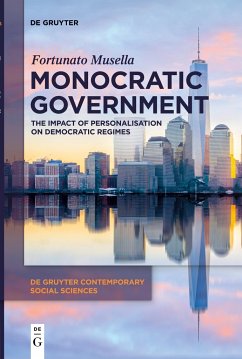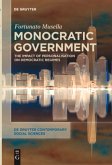12,99 €
inkl. MwSt.
Versandfertig in 6-10 Tagen

6 °P sammeln
- Broschiertes Buch
- Merkliste
- Auf die Merkliste
- Bewerten Bewerten
- Teilen
- Produkt teilen
- Produkterinnerung
- Produkterinnerung
Personalisation is the most relevant political phenomenon of our time. After the decline of structural and ideological foundations of Western democracies, a radical shift from collective to individual actors and institutions has occurred in several political systems. From the one hand political leaders have gained centrality on the democratic scene, as a consequence of both a more direct, sometimes plebiscitary, relationship with citizens, and a more direct control of the executive administration. From the other hand a process of fragmentation occurs at the mass level, where electoral…mehr
Andere Kunden interessierten sich auch für
![Monocratic Government Monocratic Government]() Fortunato MusellaMonocratic Government87,99 €
Fortunato MusellaMonocratic Government87,99 €![Beziehungen zwischen Legislative und Exekutive: Eine Studie über die Haushaltskrisen in Nigeria im Jahr 2016 Beziehungen zwischen Legislative und Exekutive: Eine Studie über die Haushaltskrisen in Nigeria im Jahr 2016]() Sanusi AbdulwasiuBeziehungen zwischen Legislative und Exekutive: Eine Studie über die Haushaltskrisen in Nigeria im Jahr 201659,90 €
Sanusi AbdulwasiuBeziehungen zwischen Legislative und Exekutive: Eine Studie über die Haushaltskrisen in Nigeria im Jahr 201659,90 €![Regierungsorganisation und politische Führung in Deutschland Regierungsorganisation und politische Führung in Deutschland]() Ludger HelmsRegierungsorganisation und politische Führung in Deutschland32,99 €
Ludger HelmsRegierungsorganisation und politische Führung in Deutschland32,99 €![The Age of Neoliberal Absolutism The Age of Neoliberal Absolutism]() Fabio ArmaoThe Age of Neoliberal Absolutism80,99 €
Fabio ArmaoThe Age of Neoliberal Absolutism80,99 €![40 Jahre Hessische Verfassung - 40 Jahre Politik in Hessen 40 Jahre Hessische Verfassung - 40 Jahre Politik in Hessen]() 40 Jahre Hessische Verfassung - 40 Jahre Politik in Hessen54,99 €
40 Jahre Hessische Verfassung - 40 Jahre Politik in Hessen54,99 €![Solidargemeinschaft und fragmentierte Gesellschaft: Parteien, Milieus und Verbände im Vergleich Solidargemeinschaft und fragmentierte Gesellschaft: Parteien, Milieus und Verbände im Vergleich]() Solidargemeinschaft und fragmentierte Gesellschaft: Parteien, Milieus und Verbände im Vergleich54,99 €
Solidargemeinschaft und fragmentierte Gesellschaft: Parteien, Milieus und Verbände im Vergleich54,99 €![Die Charta der Grundrechte der Europäischen Union Die Charta der Grundrechte der Europäischen Union]() Deutscher BundestagDie Charta der Grundrechte der Europäischen Union59,99 €
Deutscher BundestagDie Charta der Grundrechte der Europäischen Union59,99 €-
-
-
Personalisation is the most relevant political phenomenon of our time. After the decline of structural and ideological foundations of Western democracies, a radical shift from collective to individual actors and institutions has occurred in several political systems. From the one hand political leaders have gained centrality on the democratic scene, as a consequence of both a more direct, sometimes plebiscitary, relationship with citizens, and a more direct control of the executive administration. From the other hand a process of fragmentation occurs at the mass level, where electoral volatility has strongly increased and especially after the spread of social media each citizen elaborates his convictions in the self-referential autonomy of the digital networks.
This book analyses the consequences of personalisation of political leaders on democratic government, by asking whether it is possible to keep together demos and kratos in a post-particratic context. It explores topics such as governmental decrees, Trump-governance, and analysis of the coronavirus outbreak. The book brings to the fore the study of political personalization in relation to some of the most important crises and trends in modern politics. It does so offering comparative insights, exploring how political leaders govern in the United States, France, Germany, Italy, and Hungary.
This book analyses the consequences of personalisation of political leaders on democratic government, by asking whether it is possible to keep together demos and kratos in a post-particratic context. It explores topics such as governmental decrees, Trump-governance, and analysis of the coronavirus outbreak. The book brings to the fore the study of political personalization in relation to some of the most important crises and trends in modern politics. It does so offering comparative insights, exploring how political leaders govern in the United States, France, Germany, Italy, and Hungary.
Produktdetails
- Produktdetails
- De Gruyter Contemporary Social Sciences 8
- Verlag: De Gruyter
- 1. Auflage
- Seitenzahl: 162
- Erscheinungstermin: 17. Juni 2024
- Englisch
- Abmessung: 230mm x 155mm x 10mm
- Gewicht: 403g
- ISBN-13: 9783110724714
- ISBN-10: 3110724715
- Artikelnr.: 70423420
- Herstellerkennzeichnung Die Herstellerinformationen sind derzeit nicht verfügbar.
- De Gruyter Contemporary Social Sciences 8
- Verlag: De Gruyter
- 1. Auflage
- Seitenzahl: 162
- Erscheinungstermin: 17. Juni 2024
- Englisch
- Abmessung: 230mm x 155mm x 10mm
- Gewicht: 403g
- ISBN-13: 9783110724714
- ISBN-10: 3110724715
- Artikelnr.: 70423420
- Herstellerkennzeichnung Die Herstellerinformationen sind derzeit nicht verfügbar.
Fortunato Musella is Full Professor of Political Science at the University of Naples Federico II. He has been a visiting scholar at the Cornell University (Usa), visiting professor at the Sussex European Institute (UK) and Leuphana Universität (Germany), professor of Political Concepts for the Phd courses of the Scuola Superiore Normale di Pisa (2010-2017), and in Accademia Aeronautica militare (2018-2020). He has served in the Italian University Council (CUN) and in the Editorial Board of the Italian Political Science Review. Currently he is in the Executive Board of Federica WebLearning, Center for Innovation and Dissemination of Distance Learning. He is also Principal Investigator for the national project Monocratic Government. The Impact of Personalisation on Contemporary Political Regimes, financed by the Ministery of University and Research (PRIN 2020-2023). His main research interests include the study of government, presidential politics, political parties, concept analysis and digital politics. Among his recent publications, the volumes Governi monocratici. La svolta presidenziale nelle regioni italiane (Bologna, Il Mulino, 2009), Il premier diviso. Italia tra presidenzialismo e parlamentarismo (Milan, Bocconi, 2012), Political Leaders beyond Party Politics (London, Palgrave, 2017). Recently he published the book, bestseller in its category, Il Principe digitale (Roma-Bari, Laterza, 2019), dedicated to investigate changes introduced by digital technologies in politics. He has written eighty book chapters and articles in peer review journal such as European Political Science Review, Representation, Zeitschrift für Vergleichende Politikwissenschaft, Italian Political Science Review, Contemporary Italian Politics, Polis, Quaderni di Scienza Politica.
1) Introduction. Political leaders at the times of personalization of the masses
This chapter introduces to the main book's topics, by examining dimensions and directions of concepts such as "personalization of leadership" and "personalization of the masses". While the advancement of democracies has appeared as an inexorable trend in Nineteenth century, today also most consolidated democratic regimes has to face serious autocratic challenges.
2) Personal Governments
The trend towards a monocratic principle of political action, so that leaders tend to become the true dominus in governmental activities. Analysis of transformations of government will be produced with regards to changes in formal constitutions (Blondel 2015) as well as to rules and practices which moves political systems toward the consolidation of a presidential logic, even without any modification of the constitutional charters (Poguntke and Webb 2005; Musella and Webb 2015).
In this chapter trends in de iure of de facto changes in democratic regimes that have strengthened political leaders will be investigated. Developments of a set of European democracies (France, Germany, Italy, Hungary, Spain, UK) and in the United States, occurred in the last two decades decades (period: 2000-2020), will be analysed through the lens of "personalisation" and "presidentialisation". For instance, Italy has been considered an idealtype of such process, with the Presidente del Consiglio passing from being a mediator in the ministerial team to become the protagonist of executive activities. In Hungary changes have been formal one, as one may suspect that the centralisation of power on the part of Orban may mean the beginning of an autocracy. In the United States the Trump has adopted a personalistic style of government, by giving shape to a peculiar populist discourse. Structural changes in the executive administration, such as in the re-invention of the UK Cabinet office or in the turn of the German Chancellor's office from a simple administrative unit into a "formidable centre" of executive power, will be only considered.
3) The Expansion of Governmental Decrees
The new centrality of political leaders in the governmental arena has also modified the way in which legislation is enacted. Indeed, as leaders become more powerful, there has also been a tendency to give them full responsibility to govern. In some countries (such as Italy and Spain) specific provision give the government to power of enacting autonomous decrees, while in other cases administrative acts have been used as governmental instruments. The same may be said for the increasing use of presidential orders by the President of the United States of America. The consequence is that when a leader gains a large degree of popularity and visibility, he expands his role on law-making arena by also using new channels of law-making. In this chapter also specific public policies that reinforce the autonomy and the power of chief executive will be investigated, such as digital policy, security policy, and so on.
4) Direct Communication and Digital Analytics
A further element of a monocratic government is the development of a direct-not mediated by parties and often emotional-relationship between political leaders and citizens, so that the leader takes the role of a political representative "above the party" and the main channel for collecting the popular vote. As far as the leader appears full responsible for governmental action, permanent electoral campaigns are centred on his figure. Today a direct and continuous linkage between leaders and citizens represent a common pattern. More in particular digital media, along with the employment of profiling techniques and big data, have been fostering trends toward political disintermediation and the strengthening of personal leadership, by providing them with an autonomous power for setting political agenda and creating a pervasive linkage with single citizens/users. Yet the fragmentation of the web public renders the consensus democratic leaders gain more and more precarious, in a context where each citizen elaborates their convictions in the self-referential autonomy of the digital networks. And where leaders have to cope with high level of competition with other alternative and/or sub-leaders, with variable results in terms of homogeneity of the party message.
5) Micro-Personal Parties and Parliaments
This chapter aims at understanding processes of transformation of collective bodies such as political parties and parliaments. While the personalization of politics has strengthened the party leader, it does not only relate to the higher levels of party organizations, but also to all its levels and articulations, where we register the increase of autonomy and visibility of single sub-leaders. Consequently, high level of parliamentary fragmentation may be registered, as well as individualistic forms of law making. With respect to the Italian case, it should be noted that strong and visible party leaders coexisted with high levels of party indiscipline, thus showing that the influence of the Prime Minister on the executive decision making is not the same thing as directing MPs. Yet similar trends may be observed, howeverm also in other selected national cases. For instance, individualism, which is a constant element of parliamentary activities in United States, also has increased in the Congress.
6) Presidents from Primacy to Emergency
During Coronavirus Crisis the need of rapid intervention has strengthened monocratic actors. Contemporary democracies have been experienced states of exceptions and transitory suspension of the general rules which, together with restrictions on the constitutional freedoms of citizens, end up attributing to governments the extraordinary competence to exercise legislative functions. During the emergency phase, chief executives have dominated national decision-making, whereby the gross of the legislative production has been transferred from the parliamentary body to the executive and the decrees were used as an ordinary instrument of government. Furthermore, the direct methods of political communication have often emphasized their institutional position, thanks to an innovative and intensive use of old and new media.
7) Combining Demos and Kratos: a mission impossible for the future of democracy?
In the passage from party-based to leader-based democracy, this conclusive chapter reflects on the changes and future prospects of democratic regimes. Indeed, with the crisis of traditional representative institutions in their functions to collect people and channel public demands, political leaders have to face a scenario of diffuse personalization where it is very difficult to govern.
This chapter introduces to the main book's topics, by examining dimensions and directions of concepts such as "personalization of leadership" and "personalization of the masses". While the advancement of democracies has appeared as an inexorable trend in Nineteenth century, today also most consolidated democratic regimes has to face serious autocratic challenges.
2) Personal Governments
The trend towards a monocratic principle of political action, so that leaders tend to become the true dominus in governmental activities. Analysis of transformations of government will be produced with regards to changes in formal constitutions (Blondel 2015) as well as to rules and practices which moves political systems toward the consolidation of a presidential logic, even without any modification of the constitutional charters (Poguntke and Webb 2005; Musella and Webb 2015).
In this chapter trends in de iure of de facto changes in democratic regimes that have strengthened political leaders will be investigated. Developments of a set of European democracies (France, Germany, Italy, Hungary, Spain, UK) and in the United States, occurred in the last two decades decades (period: 2000-2020), will be analysed through the lens of "personalisation" and "presidentialisation". For instance, Italy has been considered an idealtype of such process, with the Presidente del Consiglio passing from being a mediator in the ministerial team to become the protagonist of executive activities. In Hungary changes have been formal one, as one may suspect that the centralisation of power on the part of Orban may mean the beginning of an autocracy. In the United States the Trump has adopted a personalistic style of government, by giving shape to a peculiar populist discourse. Structural changes in the executive administration, such as in the re-invention of the UK Cabinet office or in the turn of the German Chancellor's office from a simple administrative unit into a "formidable centre" of executive power, will be only considered.
3) The Expansion of Governmental Decrees
The new centrality of political leaders in the governmental arena has also modified the way in which legislation is enacted. Indeed, as leaders become more powerful, there has also been a tendency to give them full responsibility to govern. In some countries (such as Italy and Spain) specific provision give the government to power of enacting autonomous decrees, while in other cases administrative acts have been used as governmental instruments. The same may be said for the increasing use of presidential orders by the President of the United States of America. The consequence is that when a leader gains a large degree of popularity and visibility, he expands his role on law-making arena by also using new channels of law-making. In this chapter also specific public policies that reinforce the autonomy and the power of chief executive will be investigated, such as digital policy, security policy, and so on.
4) Direct Communication and Digital Analytics
A further element of a monocratic government is the development of a direct-not mediated by parties and often emotional-relationship between political leaders and citizens, so that the leader takes the role of a political representative "above the party" and the main channel for collecting the popular vote. As far as the leader appears full responsible for governmental action, permanent electoral campaigns are centred on his figure. Today a direct and continuous linkage between leaders and citizens represent a common pattern. More in particular digital media, along with the employment of profiling techniques and big data, have been fostering trends toward political disintermediation and the strengthening of personal leadership, by providing them with an autonomous power for setting political agenda and creating a pervasive linkage with single citizens/users. Yet the fragmentation of the web public renders the consensus democratic leaders gain more and more precarious, in a context where each citizen elaborates their convictions in the self-referential autonomy of the digital networks. And where leaders have to cope with high level of competition with other alternative and/or sub-leaders, with variable results in terms of homogeneity of the party message.
5) Micro-Personal Parties and Parliaments
This chapter aims at understanding processes of transformation of collective bodies such as political parties and parliaments. While the personalization of politics has strengthened the party leader, it does not only relate to the higher levels of party organizations, but also to all its levels and articulations, where we register the increase of autonomy and visibility of single sub-leaders. Consequently, high level of parliamentary fragmentation may be registered, as well as individualistic forms of law making. With respect to the Italian case, it should be noted that strong and visible party leaders coexisted with high levels of party indiscipline, thus showing that the influence of the Prime Minister on the executive decision making is not the same thing as directing MPs. Yet similar trends may be observed, howeverm also in other selected national cases. For instance, individualism, which is a constant element of parliamentary activities in United States, also has increased in the Congress.
6) Presidents from Primacy to Emergency
During Coronavirus Crisis the need of rapid intervention has strengthened monocratic actors. Contemporary democracies have been experienced states of exceptions and transitory suspension of the general rules which, together with restrictions on the constitutional freedoms of citizens, end up attributing to governments the extraordinary competence to exercise legislative functions. During the emergency phase, chief executives have dominated national decision-making, whereby the gross of the legislative production has been transferred from the parliamentary body to the executive and the decrees were used as an ordinary instrument of government. Furthermore, the direct methods of political communication have often emphasized their institutional position, thanks to an innovative and intensive use of old and new media.
7) Combining Demos and Kratos: a mission impossible for the future of democracy?
In the passage from party-based to leader-based democracy, this conclusive chapter reflects on the changes and future prospects of democratic regimes. Indeed, with the crisis of traditional representative institutions in their functions to collect people and channel public demands, political leaders have to face a scenario of diffuse personalization where it is very difficult to govern.
1) Introduction. Political leaders at the times of personalization of the masses
This chapter introduces to the main book's topics, by examining dimensions and directions of concepts such as "personalization of leadership" and "personalization of the masses". While the advancement of democracies has appeared as an inexorable trend in Nineteenth century, today also most consolidated democratic regimes has to face serious autocratic challenges.
2) Personal Governments
The trend towards a monocratic principle of political action, so that leaders tend to become the true dominus in governmental activities. Analysis of transformations of government will be produced with regards to changes in formal constitutions (Blondel 2015) as well as to rules and practices which moves political systems toward the consolidation of a presidential logic, even without any modification of the constitutional charters (Poguntke and Webb 2005; Musella and Webb 2015).
In this chapter trends in de iure of de facto changes in democratic regimes that have strengthened political leaders will be investigated. Developments of a set of European democracies (France, Germany, Italy, Hungary, Spain, UK) and in the United States, occurred in the last two decades decades (period: 2000-2020), will be analysed through the lens of "personalisation" and "presidentialisation". For instance, Italy has been considered an idealtype of such process, with the Presidente del Consiglio passing from being a mediator in the ministerial team to become the protagonist of executive activities. In Hungary changes have been formal one, as one may suspect that the centralisation of power on the part of Orban may mean the beginning of an autocracy. In the United States the Trump has adopted a personalistic style of government, by giving shape to a peculiar populist discourse. Structural changes in the executive administration, such as in the re-invention of the UK Cabinet office or in the turn of the German Chancellor's office from a simple administrative unit into a "formidable centre" of executive power, will be only considered.
3) The Expansion of Governmental Decrees
The new centrality of political leaders in the governmental arena has also modified the way in which legislation is enacted. Indeed, as leaders become more powerful, there has also been a tendency to give them full responsibility to govern. In some countries (such as Italy and Spain) specific provision give the government to power of enacting autonomous decrees, while in other cases administrative acts have been used as governmental instruments. The same may be said for the increasing use of presidential orders by the President of the United States of America. The consequence is that when a leader gains a large degree of popularity and visibility, he expands his role on law-making arena by also using new channels of law-making. In this chapter also specific public policies that reinforce the autonomy and the power of chief executive will be investigated, such as digital policy, security policy, and so on.
4) Direct Communication and Digital Analytics
A further element of a monocratic government is the development of a direct-not mediated by parties and often emotional-relationship between political leaders and citizens, so that the leader takes the role of a political representative "above the party" and the main channel for collecting the popular vote. As far as the leader appears full responsible for governmental action, permanent electoral campaigns are centred on his figure. Today a direct and continuous linkage between leaders and citizens represent a common pattern. More in particular digital media, along with the employment of profiling techniques and big data, have been fostering trends toward political disintermediation and the strengthening of personal leadership, by providing them with an autonomous power for setting political agenda and creating a pervasive linkage with single citizens/users. Yet the fragmentation of the web public renders the consensus democratic leaders gain more and more precarious, in a context where each citizen elaborates their convictions in the self-referential autonomy of the digital networks. And where leaders have to cope with high level of competition with other alternative and/or sub-leaders, with variable results in terms of homogeneity of the party message.
5) Micro-Personal Parties and Parliaments
This chapter aims at understanding processes of transformation of collective bodies such as political parties and parliaments. While the personalization of politics has strengthened the party leader, it does not only relate to the higher levels of party organizations, but also to all its levels and articulations, where we register the increase of autonomy and visibility of single sub-leaders. Consequently, high level of parliamentary fragmentation may be registered, as well as individualistic forms of law making. With respect to the Italian case, it should be noted that strong and visible party leaders coexisted with high levels of party indiscipline, thus showing that the influence of the Prime Minister on the executive decision making is not the same thing as directing MPs. Yet similar trends may be observed, howeverm also in other selected national cases. For instance, individualism, which is a constant element of parliamentary activities in United States, also has increased in the Congress.
6) Presidents from Primacy to Emergency
During Coronavirus Crisis the need of rapid intervention has strengthened monocratic actors. Contemporary democracies have been experienced states of exceptions and transitory suspension of the general rules which, together with restrictions on the constitutional freedoms of citizens, end up attributing to governments the extraordinary competence to exercise legislative functions. During the emergency phase, chief executives have dominated national decision-making, whereby the gross of the legislative production has been transferred from the parliamentary body to the executive and the decrees were used as an ordinary instrument of government. Furthermore, the direct methods of political communication have often emphasized their institutional position, thanks to an innovative and intensive use of old and new media.
7) Combining Demos and Kratos: a mission impossible for the future of democracy?
In the passage from party-based to leader-based democracy, this conclusive chapter reflects on the changes and future prospects of democratic regimes. Indeed, with the crisis of traditional representative institutions in their functions to collect people and channel public demands, political leaders have to face a scenario of diffuse personalization where it is very difficult to govern.
This chapter introduces to the main book's topics, by examining dimensions and directions of concepts such as "personalization of leadership" and "personalization of the masses". While the advancement of democracies has appeared as an inexorable trend in Nineteenth century, today also most consolidated democratic regimes has to face serious autocratic challenges.
2) Personal Governments
The trend towards a monocratic principle of political action, so that leaders tend to become the true dominus in governmental activities. Analysis of transformations of government will be produced with regards to changes in formal constitutions (Blondel 2015) as well as to rules and practices which moves political systems toward the consolidation of a presidential logic, even without any modification of the constitutional charters (Poguntke and Webb 2005; Musella and Webb 2015).
In this chapter trends in de iure of de facto changes in democratic regimes that have strengthened political leaders will be investigated. Developments of a set of European democracies (France, Germany, Italy, Hungary, Spain, UK) and in the United States, occurred in the last two decades decades (period: 2000-2020), will be analysed through the lens of "personalisation" and "presidentialisation". For instance, Italy has been considered an idealtype of such process, with the Presidente del Consiglio passing from being a mediator in the ministerial team to become the protagonist of executive activities. In Hungary changes have been formal one, as one may suspect that the centralisation of power on the part of Orban may mean the beginning of an autocracy. In the United States the Trump has adopted a personalistic style of government, by giving shape to a peculiar populist discourse. Structural changes in the executive administration, such as in the re-invention of the UK Cabinet office or in the turn of the German Chancellor's office from a simple administrative unit into a "formidable centre" of executive power, will be only considered.
3) The Expansion of Governmental Decrees
The new centrality of political leaders in the governmental arena has also modified the way in which legislation is enacted. Indeed, as leaders become more powerful, there has also been a tendency to give them full responsibility to govern. In some countries (such as Italy and Spain) specific provision give the government to power of enacting autonomous decrees, while in other cases administrative acts have been used as governmental instruments. The same may be said for the increasing use of presidential orders by the President of the United States of America. The consequence is that when a leader gains a large degree of popularity and visibility, he expands his role on law-making arena by also using new channels of law-making. In this chapter also specific public policies that reinforce the autonomy and the power of chief executive will be investigated, such as digital policy, security policy, and so on.
4) Direct Communication and Digital Analytics
A further element of a monocratic government is the development of a direct-not mediated by parties and often emotional-relationship between political leaders and citizens, so that the leader takes the role of a political representative "above the party" and the main channel for collecting the popular vote. As far as the leader appears full responsible for governmental action, permanent electoral campaigns are centred on his figure. Today a direct and continuous linkage between leaders and citizens represent a common pattern. More in particular digital media, along with the employment of profiling techniques and big data, have been fostering trends toward political disintermediation and the strengthening of personal leadership, by providing them with an autonomous power for setting political agenda and creating a pervasive linkage with single citizens/users. Yet the fragmentation of the web public renders the consensus democratic leaders gain more and more precarious, in a context where each citizen elaborates their convictions in the self-referential autonomy of the digital networks. And where leaders have to cope with high level of competition with other alternative and/or sub-leaders, with variable results in terms of homogeneity of the party message.
5) Micro-Personal Parties and Parliaments
This chapter aims at understanding processes of transformation of collective bodies such as political parties and parliaments. While the personalization of politics has strengthened the party leader, it does not only relate to the higher levels of party organizations, but also to all its levels and articulations, where we register the increase of autonomy and visibility of single sub-leaders. Consequently, high level of parliamentary fragmentation may be registered, as well as individualistic forms of law making. With respect to the Italian case, it should be noted that strong and visible party leaders coexisted with high levels of party indiscipline, thus showing that the influence of the Prime Minister on the executive decision making is not the same thing as directing MPs. Yet similar trends may be observed, howeverm also in other selected national cases. For instance, individualism, which is a constant element of parliamentary activities in United States, also has increased in the Congress.
6) Presidents from Primacy to Emergency
During Coronavirus Crisis the need of rapid intervention has strengthened monocratic actors. Contemporary democracies have been experienced states of exceptions and transitory suspension of the general rules which, together with restrictions on the constitutional freedoms of citizens, end up attributing to governments the extraordinary competence to exercise legislative functions. During the emergency phase, chief executives have dominated national decision-making, whereby the gross of the legislative production has been transferred from the parliamentary body to the executive and the decrees were used as an ordinary instrument of government. Furthermore, the direct methods of political communication have often emphasized their institutional position, thanks to an innovative and intensive use of old and new media.
7) Combining Demos and Kratos: a mission impossible for the future of democracy?
In the passage from party-based to leader-based democracy, this conclusive chapter reflects on the changes and future prospects of democratic regimes. Indeed, with the crisis of traditional representative institutions in their functions to collect people and channel public demands, political leaders have to face a scenario of diffuse personalization where it is very difficult to govern.







